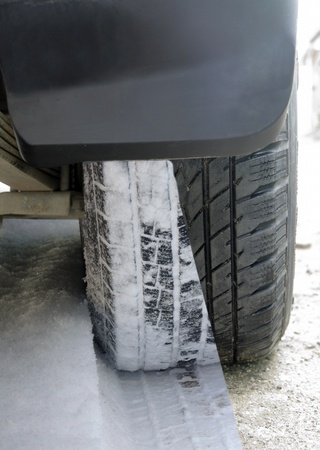Deciding which tires are best for your vehicle often depends on the time of year and where you live. Chances are your vehicle is outfitted with all-season tires, especially if it has recently left the factory. While these tires can sometimes be fine throughout the entire year, you may need to switch to winter tires for a few months at a time, especially if you’ll be driving in snowy or icy areas. Understanding the differences between these two types of tires can help you make the right decision for your vehicle.
 One of the main factors to consider when choosing between these two types of tires is tread. The tread rubber on all-season tires is generally suitable most of the time, but cold temperatures can cause this rubber to stiffen. This, in turn, provides the vehicle with less traction on the road in cooler conditions. If you find you aren’t able to control your vehicle as well in cold temperatures and you have all-season tires, the rubber compounds on winter tires may be a better solution for you.
One of the main factors to consider when choosing between these two types of tires is tread. The tread rubber on all-season tires is generally suitable most of the time, but cold temperatures can cause this rubber to stiffen. This, in turn, provides the vehicle with less traction on the road in cooler conditions. If you find you aren’t able to control your vehicle as well in cold temperatures and you have all-season tires, the rubber compounds on winter tires may be a better solution for you.
All-season and winter tires also differ when it comes to biting edges. Unlike all-season tires, winter tires have many slits built into the tread. These biting edges provide added traction, especially if when you are driving on icy roads, and in some places, molded holes allow studs to be inserted. While very uncommon in this area of the country, if you’ll be traveling out of state or to mountainous regions, you may want to consider switching to winter tires so that you have greater traction on the roads.
Winter tires also have tread that is generally much deeper than anything found on all-season tires. This helps the tires maintain traction and assist with driving over snow and slush. However, winter tires can be less effective in especially wet conditions. As these tires have deeper treads, they also have less surface area that comes in contact with the road, which can lead to a slight reduction in stopping power on wet roads.
If you do decide to install winter tires for a few months at a time, make sure you change both the front and back tires. Changing just one or the other won’t protect you from sliding on the road. Once the temperature rises and the winter season disappears, make sure that you put the all-season tires back on your vehicle. Keeping winter tires on after the season ends can not only cause them to wear out more quickly, but also will lead to reduced gas mileage in the warmer months.
For more information about all-season and winter tires – or any other questions about your vehicle – give us a call at 661-949-1999!




